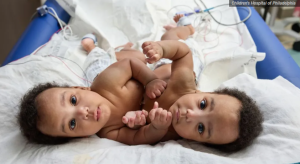 Conjoined twins Amari and Javar Ruffin were successfully separated at Children’s Hospital of Philadelphia in August, 2024. Read their full story in the “Learn more” section below.
Conjoined twins Amari and Javar Ruffin were successfully separated at Children’s Hospital of Philadelphia in August, 2024. Read their full story in the “Learn more” section below.
What are conjoined twins?
Managing a pregnancy with conjoined twins can feel overwhelming. But learning more and working closely with your team can help you know what to expect and how to advocate for your and your babies’ best possible care.
The term conjoined twins refers to identical twins whose bodies are physically fused to each other in the womb and remain so even after birth. This occurs when a single fertilized egg begins to split into two babies but does not do so completely. This is a rare occurrence, happening only once in about 50,000 pregnancies (according to Children’s Hospital of Philadelphia.)
How are conjoined twins diagnosed?
Typically, a diagnosis of conjoined twins occurs early in pregnancy by using prenatal ultrasound. Further evaluations are later conducted, usually after 18 weeks, using ultrasound, MRI, and echocardiogram technology to understand the location and extent of the connection and help determine whether separation surgery after birth is possible.
Conjoined twins are categorized by where they are connected. Approximately 75% are joined at the chest wall or upper abdomen, 23% are connected at the hips, legs, or genitalia, and only 2% are joined at the head.
What are the health risks associated with conjoined twin deliveries?
Conjoined twins must always be delivered by C-section, which can carry certain maternal risks including: infection, loss of blood, blood clots, organ injury, risks to future pregnancies, and more. Other risks include miscarriage, preterm birth, and neonatal death. It is important to deliver your babies at a facility that has a wide range of specialized services to ensure the best outcome for you and your babies.
Can conjoined twins be separated?
Depending on where the babies are connected and the extent of organs that are shared, separation surgery can be a viable option. This is a long, delicate, and complex operation with risks to one or both babies involving a large team of doctors and medical professionals. There are usually subsequent reconstructive surgeries required to complete the separation process.
Additional Resources
Children’s Hospital of Philadelpha
Learn more
